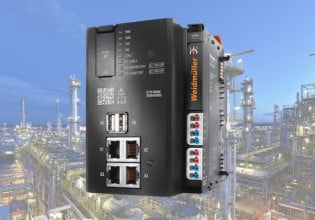Easing the IT/OT Burden With OnLogic’s New Thin Client PC
OnLogic has added to the existing ThinManager-ready PC product line with a new thin client with WiFi boot functionally to add multiple HMI functionality with a central point of maintenance.
In a control automation world dominated by digital controls, it should stand to reason that PCs would be used more heavily, with both robust ‘edge’ hardware and field-level software designed to bridge the space between the shop floor and enterprise optimization.
OnLogic Industrial PCs
When it comes to edge computing in an industrial environment, OnLogic provides a wide selection of solutions. The company’s industrial panel-mount PCs can operate in environments that typical PCs can’t reliably handle, and they are built with an abundance of I/O capabilities.
Recently, OnLogic released the TM260, a ThinManager-ready thin client with WiFi boot capability.

OnLogic’s new ThinManager edge client device. Image used courtesy of OnLogic
Ok, But What Is A “Thin Client?”
For hardware engineers, it’s worth discussing the background behind the technology that operates in an IT/OT world.
A thin client is a stripped-down PC with a bare minimum of graphics and data access hardware, designed to be networked with a server. The server does all the heavy computer processing and data storage while the thin client simply displays the information. Thin clients are capable of application virtualization and desktop virtualization, essentially forming an on-premises cloud system.
Since all of the computing is accomplished on the server machine, software updates, program development, and central storage can be maintained in one location, greatly easing the IT/OT burden when changes need to happen.

The high-level overview of a thin client/server system. Image used courtesy of Wikipedia
TM260 By OnLogic
The TM260 is based on the Helix 330, also offered by OnLogic, and is essentially a fanless PC that can be mounted inside electrical panels. One of the differences between the two systems is the TM260 is a ThinManager-ready PC, so right out of the box, your device is ready to be installed as a thin client within your network. The TM260 comes pre-installed with ThinManager 11 and firmware package 9 or above, has 6 USB ports, and will support three independent 4K displays.
A very handy feature is the WiFi boot capability. With industrial PCs being installed in electrical panels, it can be hard to power on the PC if the panel is locked. Most factories keep their electrical panels locked out from untrained personnel. With the WiFi boot functionally, the TM260 can be booted remotely and wirelessly.
The TM260 is powered by Intel’s latest Celeron and Pentium processors and there are 1x or 2x GbE LAN ports available. The standard model has 8Gb of DDR4 RAM, Intel UHD Graphics, and an expansion slot for an M.2 E-key. All this hardware is provided in a sleek fanless low-profile case.
Smart Factory Solutions
Factories are pushing equipment builders to provide smarter and more advanced solutions at lower costs. One way of cutting costs with larger equipment is to take advantage of a ThinManager and Thin Client solution for HMIs.
On a typical machine, the job of the HMI is to allow operators to interface with the automation, this is commonly done by using a PLC or panel PC with integrated HMI, then designing the HMI software runtime. If your project only has a few HMIs, this design works quite well, but when your equipment has more HMIs, using thin clients can save quite a bit of money.
With a thin client, the server contains the project runtime and each thin client accesses the information over the network. This design requires a fast, efficiently laid-out network to eliminate network conflicts and interruptions, since a lot of data is being transferred. The server will have access to the HMI network and the automation network. The ThinManger OS is installed on the BIOS, so there is no need for a hard drive within the thin client itself.
As automation grows in all kinds of facilities, the need for lower time and effort in project development and maintenance is absolutely essential. Edge PCs and thin clients are two building blocks that can be used to ease this journey into so-called ‘digital transformation,’ stripping away the IT buzzwords with actual, efficient solutions.






